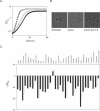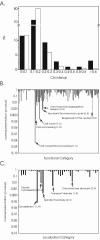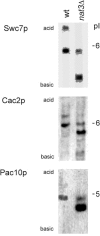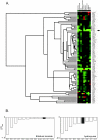Physiological importance and identification of novel targets for the N-terminal acetyltransferase NatB
- PMID: 16467477
- PMCID: PMC1405896
- DOI: 10.1128/EC.5.2.368-378.2006
Physiological importance and identification of novel targets for the N-terminal acetyltransferase NatB
Abstract
The N-terminal acetyltransferase NatB in Saccharomyces cerevisiae consists of the catalytic subunit Nat3p and the associated subunit Mdm20p. We here extend our present knowledge about the physiological role of NatB by a combined proteomics and phenomics approach. We found that strains deleted for either NAT3 or MDM20 displayed different growth rates and morphologies in specific stress conditions, demonstrating that the two NatB subunits have partly individual functions. Earlier reported phenotypes of the nat3Delta strain have been associated with altered functionality of actin cables. However, we found that point mutants of tropomyosin that suppress the actin cable defect observed in nat3Delta only partially restores wild-type growth and morphology, indicating the existence of functionally important acetylations unrelated to actin cable function. Predicted NatB substrates were dramatically overrepresented in a distinct set of biological processes, mainly related to DNA processing and cell cycle progression. Three of these proteins, Cac2p, Pac10p, and Swc7p, were identified as true NatB substrates. To identify N-terminal acetylations potentially important for protein function, we performed a large-scale comparative phenotypic analysis including nat3Delta and strains deleted for the putative NatB substrates involved in cell cycle regulation and DNA processing. By this procedure we predicted functional importance of the N-terminal acetylation for 31 proteins.
Figures






Similar articles
-
The stress-induced Tfs1p requires NatB-mediated acetylation to inhibit carboxypeptidase Y and to regulate the protein kinase A pathway.J Biol Chem. 2004 Sep 10;279(37):38532-43. doi: 10.1074/jbc.M402939200. Epub 2004 Jun 30. J Biol Chem. 2004. PMID: 15229224
-
Nat3p and Mdm20p are required for function of yeast NatB Nalpha-terminal acetyltransferase and of actin and tropomyosin.J Biol Chem. 2003 Aug 15;278(33):30686-97. doi: 10.1074/jbc.M304690200. Epub 2003 Jun 3. J Biol Chem. 2003. PMID: 12783868
-
Mdm20 protein functions with Nat3 protein to acetylate Tpm1 protein and regulate tropomyosin-actin interactions in budding yeast.Proc Natl Acad Sci U S A. 2003 Jun 24;100(13):7644-9. doi: 10.1073/pnas.1232343100. Epub 2003 Jun 13. Proc Natl Acad Sci U S A. 2003. PMID: 12808144 Free PMC article.
-
N-terminal acetyltransferases and sequence requirements for N-terminal acetylation of eukaryotic proteins.J Mol Biol. 2003 Jan 24;325(4):595-622. doi: 10.1016/s0022-2836(02)01269-x. J Mol Biol. 2003. PMID: 12507466 Review.
-
Composition and function of the eukaryotic N-terminal acetyltransferase subunits.Biochem Biophys Res Commun. 2003 Aug 15;308(1):1-11. doi: 10.1016/s0006-291x(03)01316-0. Biochem Biophys Res Commun. 2003. PMID: 12890471 Review.
Cited by
-
Characterization of semisynthetic and naturally Nα-acetylated α-synuclein in vitro and in intact cells: implications for aggregation and cellular properties of α-synuclein.J Biol Chem. 2012 Aug 17;287(34):28243-62. doi: 10.1074/jbc.M112.383711. Epub 2012 Jun 20. J Biol Chem. 2012. PMID: 22718772 Free PMC article.
-
Mutation of an Arabidopsis NatB N-alpha-terminal acetylation complex component causes pleiotropic developmental defects.PLoS One. 2013 Nov 14;8(11):e80697. doi: 10.1371/journal.pone.0080697. eCollection 2013. PLoS One. 2013. PMID: 24244708 Free PMC article.
-
NatB-Mediated N-Terminal Acetylation Affects Growth and Biotic Stress Responses.Plant Physiol. 2020 Feb;182(2):792-806. doi: 10.1104/pp.19.00792. Epub 2019 Nov 19. Plant Physiol. 2020. PMID: 31744933 Free PMC article.
-
Genetic Polymorphisms Associated with the Neutrophil⁻Lymphocyte Ratio and Their Clinical Implications for Metabolic Risk Factors.J Clin Med. 2018 Aug 8;7(8):204. doi: 10.3390/jcm7080204. J Clin Med. 2018. PMID: 30096757 Free PMC article.
-
VDACs Post-Translational Modifications Discovery by Mass Spectrometry: Impact on Their Hub Function.Int J Mol Sci. 2021 Nov 27;22(23):12833. doi: 10.3390/ijms222312833. Int J Mol Sci. 2021. PMID: 34884639 Free PMC article. Review.
References
-
- Behnia, R., B. Panic, J. R. Whyte, and S. Munro. 2004. Targeting of the Arf-like GTPase Arl3p to the Golgi requires N-terminal acetylation and the membrane protein Sys1p. Nat. Cell Biol. 6:405-413. - PubMed
-
- Blomberg, A. 2002. Use of two-dimensional gels in yeast proteomics. Methods Enzymol. 350:559-584. - PubMed
-
- Caesar, R., and A. Blomberg. 2004. The stress-induced Tfs1p requires NatB-mediated acetylation to inhibit carboxypeptidase Y and to regulate the protein kinase A pathway. J. Biol. Chem. 279:38532-38543. - PubMed
-
- Driessen, H. P., W. W. de Jong, G. I. Tesser, and H. Bloemendal. 1985. The mechanism of N-terminal acetylation of proteins. CRC Crit. Rev. Biochem. 18:281-325. - PubMed
Publication types
MeSH terms
Substances
LinkOut - more resources
Full Text Sources
Molecular Biology Databases
Miscellaneous

